#iulius ii
Text
Plutarchus – Vitae prallelae, «Vita Alexandri», I, 2-3
Οὔτε γὰρ ἱστορίας γράφομεν, ἀλλὰ
βίους, οὔτε ταῖς ἐπιφανεστάταις πράξεσι πάντως ἔνεστι
δήλωσις ἀρετῆς ἢ κακίας, ἀλλὰ πρᾶγμα βραχὺ πολλάκις
καὶ ῥῆμα καὶ παιδιά τις ἔμφασιν ἤθους ἐποίησε μᾶλλον
ἢ μάχαι μυριόνεκροι καὶ παρατάξεις αἱ μέγισται καὶ
πολιορκίαι πόλεων. Ὥσπερ οὖν οἱ ζῳγράφοι τὰς ὁμοιότητας
ἀπὸ τοῦ προσώπου καὶ τῶν περὶ τὴν ὄψιν εἰδῶν
οἷς ἐμφαίνεται τὸ ἦθος ἀναλαμβάνουσιν, ἐλάχιστα τῶν
λοιπῶν μερῶν φροντίζοντες, οὕτως ἡμῖν δοτέον εἰς τὰ
τῆς ψυχῆς σημεῖα μᾶλλον ἐνδύεσθαι, καὶ διὰ τούτων
εἰδοποιεῖν τὸν ἑκάστου βίον, ἐάσαντας ἑτέροις τὰ μεγέθη
καὶ τοὺς ἀγῶνας.
[LAT] Non enim historias, sed vitas scribimus; neque semper clarissimis factis virtutis aut vitii insunt indicia, quia immo saepe exigua quaedam res dictumve aut iocus plus de ingenio alicuius documenti praebet, quam immensa hostium strages edita, maximae pugnae, urbiumve oppugnationes. Itaque sicuti pictores vultu et habitu externo faciei ex quibus potissimum natura hominis apparet similitudines exprimunt, minima reliquarum partium habita ratione; ita nobis quoque concedendum est, ut signa animi colligentes, iis vitam uniuscuiusque depingamus, aliis magnitudinem factorum et certamina relinquentes.
[HIS] No escribimos historias, sino vidas; no es en las acciones más ruidosas donde se manifiestan la virtud o el vicio, sino que muchas veces una situación pasajera, un dicho o una niñería sirven más para declarar un carácter que batallas en que mueren millares de hombres, numerosos ejércitos y sitios de ciudades. Por tanto, de la manera como los pintores toman para retratar las semejanzas del rostro y aquella expresión de ojos en que más se manifiestan la índole y el carácter cuidándose poco de todo lo demás, así debe a nosotros concedérsenos que atendamos más a los indicios del ánimo y que por ello dibujemos la vida de cada uno dejando a otros los hechos de gran apariencia y los combates.
#Plutarchus#Πλούταρχος#Vitae parallelae#Vita Alexandri#Βίοι Παράλληλοι#Αλεξανδρος και Καισαρ#saec. I#saec. II#95#120#scriptum#historia#Graece#Alexander Magnus#Caesar#Iulius Caesar#Xylander#Ambroise Firmin-Didot
0 notes
Text
IV
These are the styles and regnal names of historic and current monarchs of sovereign countries in Latin. Hereunder, I will explain the meaning and significance of each.
Augustus — Imperator Caesar divi Iulii filius Augustus
A citizen of ancient Rome was often known by many names throughout their lifetime. The Romans had a system of personal nomenclature known as tria nomina (literally, "three names") comprising a given name (praenomen), a hereditary name (nomen gentilicium), and a cognomen, which originally served as a nickname but later became a hereditary name as an augmentation of the nomen. Perhaps history's most famous Roman, the consul Julius Caesar, was known as Gaius Iulius Caesar:
Gaius was his personal name;
Iulius indicated his belonging to the gens Julia, a ruling-class patrician family; and
Caesar indicated he belonged in specific to the most prestigious branch of the gens Julia, the Julii Caesares.
Caesar's ally and later enemy Pompey the Great was known as Gnaeus Pompeius Magnus. Again,
Gnaeus was his personal name;
Pompeius indicated his belonging to the gens Pompeia, conversely a lower-class plebeian family; but
Magnus was a cognomen Pompey earned for his military and political prowess in tribute to Alexander of Macedon, who was known and beloved in the Latin world as Magnus Alexander ("Alexander the Great").
Like his peers, Octavian was known by many names. At birth, he was Gaius Octavius, his nomen by virtue of his birth into the gens Octavia. Later, he took on the name of his granduncle and adoptive father, becoming Gaius Iulius Caesar Octavianus. Octavianus is the adjectival form of his nomen.
In 27 BC, following his victory against Mark Antony in the Battle of Actium, Octavian was acclaimed by the Senate as Princeps Civitatis ("first citizen"). Befitting his elevated status, he adopted a new name: Imperator Caesar divi Iulii filius Augustus.
In place of a praenomen, he adopted the military honorific imperator, meaning "commander." Roman militants who won the respect of their legionaries were acclaimed by the latter as imperator after a major victory. Julius Caesar was himself acclaimed imperator twice in his lifetime, once by his troops after a victory in Spain and once more by the Senate. In choosing to always be known as imperator, Octavian desired to associate the Senate and People of Rome with perennial victory. If you're very clever, you'll have noticed imperator is the root from which we derive the word "emperor," and princeps the root wherefrom "prince" comes.
Caesar, of course, reflects Octavian's status as an adopted member of the Julii Caesares.
Divi Iulii filius means "son of the divine Julius." After becoming ruler of the Roman state, Octavian took great measures to lionize and canonize the man unto whom he owed his legacy. The Roman imperial cult, the theory of divine right in its infancy, began with the canonization of Julius Caesar as himself a god. This move allowed Octavian to proclaim divinely sanctioned authority to govern as sole ruler of Rome.
Augustus, the name by which Octavian is most commonly known, was originally an obscure religious title in the republican era before being elevated as the honorific that signaled control of the Roman Empire. Thereon, a Roman became emperor when the Senate granted them the title augustus.
William the Conqueror — Rex Anglorum
William, Duke of Normandy, conquered the Kingdom of England in 1066, changing the British cultural and political landscape from predominantly Anglo-Saxon to predominantly Norman French. Everything from the kingdom's legal system to its language evolved dramatically. We have largely the Normans to thank for a heavily Greco-Latinate lexicon to supplement the Teutonic base from which Old English arose.
The Duke of Normandy acceded to the throne simply as Rex Anglorum ("King of the English"), a title first used by the Anglo-Saxon king Æthelstan in 927.
Elizabeth II — Elizabeth Secunda, Dei Gratia Britanniarum Regnorumque Suorum Ceterorum Regina, Consortionis Populorum Princeps, Fidei Defensor
The above is one of two official variations of the style of the British sovereign, the English and the Latin. As a matter of both personal style and convenience, however, this title is abbreviated by the Queen herself when signing her name simply as "Elizabeth R." Citations for court cases are customarily truncated to "R. v. Doe." During the era of direct rule over India by the British Empire, the sovereign would style themselves by their regnal name and "R. I.," meaning rex imperator (if male) or regina imperatrix (if female), respectively translating to "king-emperor" and "queen-empress." This titulature reflects the status of the king or queen regnant of the United Kingdom simultaneously serving as the emperor or empress regnant of India. Since after cession of India from the United Kingdom, of course, this title is no longer in use.
When offered the title "Emperor of the British Isles," George III refused. In addition to being king of Great Britain and Ireland, George was also, by virtue of heredity, prince-elector of Hanover, a state of the Holy Roman Empire. Should he have assumed the reign of British emperor, George III would have been an emperor who, in his capacity as an elector, swore fealty to an emperor.
Elizabeth Secunda means "Elizabeth, the second of her name," as Elizabeth Windsor is the second English queen of the same name since Elizabeth Tudor, known as Elizabeth I or the "Virgin Queen." But wait—wasn't Elizabeth Windsor's mother also a queen? Yes, she was. And wasn't she called Queen Elizabeth? She was, indeed. But that Elizabeth was queen in virtue of marriage to the king, George VI, the father of Elizabeth II. The difference is Elizabeth's mother, Elizabeth, was queen consort and thus accorded the title because she was the spouse of a reigning king. Elizabeth II, however, is a queen regnant, meaning she rules by her own right. Therefore, unless there were two Elizabeths previous to her, she could not have been styled "Elizabeth III."
Dei Gratia means "by the Grace of God." This title reflects the theory of divine right, a political and religious idea that legitimates the unfettered authority of a monarch by claiming the sovereignty of the same comes not from any earthly power but from God. In her capacity as queen, Elizabeth II answers to God in her duties, not the public. Needless to say, this doctrine has been wielded with impunity by absolute rulers to legitimize tyranny.
Britanniarum Regnum is the Latin name of the United Kingdom of Great Britain. Suorum Ceterorum means "his or her other realms," denoting the queen's status as not only sovereign of the United Kingdom but of 14 other Commonwealth realms and various dependencies of the U.K. Consortionis Populorum Princeps means "Head of the Commonwealth [of Nations]".
The title Fidei Defensor ("Defender of the Faith") was first conferred upon a British monarch, specifically King James IV of Scotland, by Pope Julius II in 1507, well before England broke communion with Rome in 1530 during the reign of Henry VIII. That the style of the British sovereign retains this title today means it survived the conversion of the liturgy of an entire realm from Latin to Anglican and the personal and later real union of the English, Scottish, and Irish crowns. Its presence also means the United Kingdom ranks among the only sovereign countries remaining that practice full-on caesaropapism, where the head of state (Caesar) is also the high priest (summus pontifex).
Francis — Franciscus, Episcopus Romanus, Vicarius Christi, Successor principis apostolorum, Caput Universalis Ecclesiae, Pontifex Maximus Ecclesiae Universalis, Patriarcha Occidentis, Primas Italiae, Archiepiscopus et metropolitanus provinciae ecclesiasticae Romanae, Princeps sui iuris Civitatis Vaticanae, Servus servorum Dei
The first thing to notice about Pope Francis' official list of titles is the absence of "pope." That's because, since at least the third century, "pope" referred to any kind of bishop.
Now, of course, "the pope" almost always denotes the bishop of Rome (Episcopus Romanus), the head of the Catholic Church (Caput Universalis Ecclesiae) and its high priest (Pontifex Maximus). Vicarius Christi is "Vicar of Christ," referring to the pope's primary mission as the earthly representative of God begotten of flesh.
As of 2006, Patriarcha Occidentis is obsolete. It means "patriarch of the West," in contradistinction to the ecumenical patriarch of the Eastern Orthodox Church, the archbishop of Constantinople, New Rome. Any inclusion of this title has been meant to explicitly acknowledge the break of communion between the Greek East and the Latin West since 1054.
Primas Italiae ("primate of Italy") and Archiepiscopus et metropolitanus provinciae ecclesiasticae Romanae ("archbishop and metropolitan of the Roman Province") reflect the Roman pontiff's status as an archbishop.
Princeps sui iuris Civitatis Vaticanae indicates the pope's role as ruler of the Vatican City State. Because of its use to identify the Roman emperor, princeps or primus ("first, foremost") is the standard Latin translation for "head of state." Perhaps the most interesting part of papal titulature is sui iuris, meaning "of one's own right." This term is used almost exclusively by the Catholic Church to denote churches with varying degrees of autonomy from Rome. In the context of the papal style, therefore, sui iuris probably refers to the pope's own autonomy in jurisdiction over the Vatican, its boundaries, its laws, and its politics.
The final item in the papal style is Servus servorum Dei ("servant of the servants of God"). This title was first used by Pope Gregory I as a sort of humble-brag in contrast to his eastern counterpart, John the Faster, assuming the more overtly preeminent "ecumenical patriarch" title.
3 notes
·
View notes
Text
ÎNVAȚĂ DE LA EI (II) – IULIUS CEZAR
Debarcând pe țărmurile Britaniei împreună cu legiunile romane, Iulius Cezar a făcut un pas important și decisiv pentru a asigura succesul intreprinderilor sale militare. Comandându-le oamenilor săi să mărșăluiască înspre marginea Stâncii Dover, le-a poruncit să privească la marea care se afla jos. Spre uimirea lor, au văzut cum ardeau toate navele cu care trecuseră ei canalul. Cezar eliminase în…
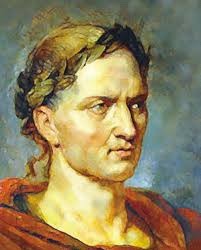
View On WordPress
0 notes
Text
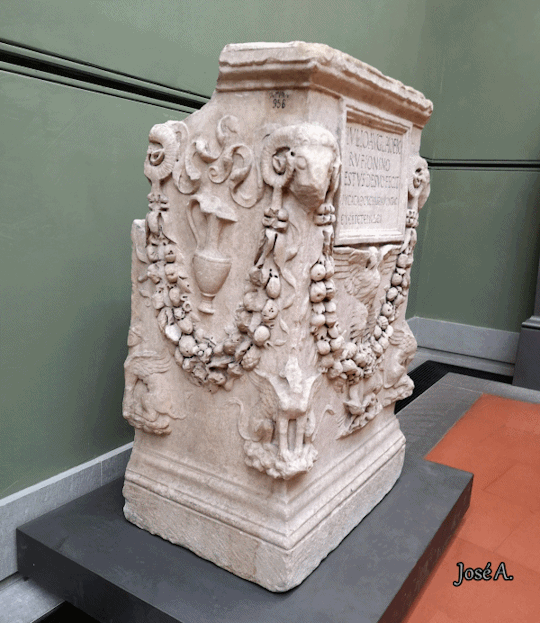
Arte romano
Altar de Caius Iulius Phoebus Rufioninus
Finales del siglo I d.C. - principios del siglo II d.C.
Mármol griego
Inv. 1914 núm. 956
Procedencia: Roma; luego en Florencia en la colección Gaddi. En la Galería desde 1780.
El altar funerario está decorado en bajorrelieve por un festón con frutas y cintas ondulantes, sostenido por protomos de carnero; en la parte central, bajo el epígrafe, se representa un águila con las alas desplegadas. Bajo la guirnalda, una loba de perfil amamanta a los cachorros con la cabeza vuelta hacia ellos. En los lados menores aún se conservan ricos festones en cuyo interior se representan los instrumentos para la libación ritual. El monumento está dedicado al liberto Rufioninus y fue construido a expensas de Cestus. Al final de la inscripción, una máxima moralizante en griego llama a honrar a los buenos ya los muertos.
Información de la Gallerie degli Uffizi, imagen/es de mi autoría.
0 notes
Photo



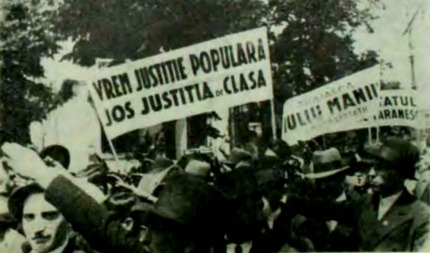

611) Partidul Național Țărănesc, Partidul Național-Țărănist, PNȚ, National Peasants' Party, National Peasant Party, National Farmers' Party, Narodowa Partia Chłopska, Narodowa Partia Rolników - agrarna partia polityczna w Królestwie Rumunii. Powstała w 1926 r. w wyniku połączenia Partidul Național Român (PNR), konserwatywno-regionalnej grupy skupionej w Siedmiogrodzie i Partidul Țărănesc, PȚ, która połączyła lewicowy ruch rolniczy w Starym Królestwie i Besarabii. Ostateczna fuzja PNR – PȚ nastąpiła po dziesięcioletnim zbliżeniu, w wyniku którego powstał wiarygodny pretendent do dominującej Partidul Național Liberal, PNL. Narodowi Chłopi zgodzili się co do koncepcji „państwa chłopskiego”, które broniło drobnego gospodarstwa przed kapitalizmem państwowym lub socjalizmem państwowym, proponując dobrowolne spółdzielcze rolnictwo jako podstawę polityki gospodarczej. Chłopi byli postrzegani jako pierwsza obrona rumuńskiego nacjonalizmu i monarchicznego reżimu kraju, czasami w ramach systemu korporacjonizmu społecznego. W regionie partia wyraziła sympatię dla bałkańskiego federalizmu i zebrała się z International Agrarian Bureau; wewnętrznie opowiadał się za decentralizacją administracyjną i poszanowaniem praw mniejszości, a także, krótko mówiąc, za republikanizmem. Pozostał podzielony na frakcje, głównie z powodów ideologicznych, co doprowadziło do serii dezercji. Atakami na establishment PNL, PNȚ poparł autorytarną monarchię, nie stawiając oporu spiskowi, który sprowadził Karola II na rumuński tron w 1930 r. W ciągu następnych pięciu lat Karol manewrował przeciwko PNȚ, która sprzeciwiała się jego próbom obalenia liberalnej demokracji. Rządy PNȚ były u władzy przez większość czasu między 1928 a 1933 rokiem, z liderem Iuliu Maniu jako najdłużej urzędującym premierem. Wspierani przez rumuńskich socjaldemokratów, rozszerzyli rumuńskie państwo opiekuńcze, ale nie poradzili sobie z Wielkim Kryzysem i zorganizowali represje wobec zradykalizowanych robotników w Lupeni i Grivița. Ta kwestia doprowadziła Maniu do konfliktu ze zdelegalizowaną Partidul Comunist Român, PCR, chociaż PNȚ, a zwłaszcza jej lewica, opowiadały się za rumuńskim frontem ludowym. Od 1935 r. Większość centrowego skrzydła opowiadała się za antyfaszyzmem, przegłosowując skrajną prawicę PNȚ, która oddzieliła się jako Frontul Românesc, FR pod rządami Alexandru Vaida-Voevoda; w tym okresie PNȚ utworzyły prodemokratyczne jednostki paramilitarne, czyli Maniu Guards. Jednak partia podpisała tymczasową umowę o współpracy z faszystowską Garda de Fier przed wyborami krajowymi w 1937 roku, wywołując wiele kontrowersji wśród własnych wyborców. PNȚ został zdelegalizowany w ramach Frontul Renașterii Naționale, FRN (1938–1940), który wchłonął również jego centrystów. Przegrupowana pod rządami Maniu, pozostawała aktywna przez całą II wojnę światową jako organizacja podziemna, tolerowana przez kolejne reżimy faszystowskie, ale wspierająca mocarstwa sprzymierzone; organizował także protesty przeciwko deportacjom mniejszości i zwrotowi północnej Transylwanii. Wraz z PNL i komunistami dokonała przewrotu sierpniowego 1944 r., stając się najpotężniejszą partią późniejszego demokratycznego interludium (1944–1946). W tym ostatnim okresie narodowi chłopi byli represjonowani jako podżegacze antykomunistycznego oporu. PNȚ został zarejestrowany jako przegrany w sfałszowanych wyborach w 1946 r. i został zdelegalizowany po „sprawie Tămădău” z 1947 r. Reżim komunistyczny masowo więził swoich członków, chociaż niektórym z prokomunistycznej lewicy pozwolono wyjść na wolność. Zarówno Maniu, jak i jego bardziej lewicowy zastępca, Ion Mihalache, zmarli w więzieniu. Komórki PNȚ zostały wskrzeszone w diasporze rumuńskiej przez liderów młodzieżowych, takich jak Ion Rațiu, i miały reprezentację w Comitetul Național Român, CNR. Uwolnienie więźniów politycznych pozwoliło również PNȚ na istnienie w Rumunii. Corneliu Coposu wyłonił się jako podziemny przywódca tego nurtu, który został przyjęty do Christian Democrat World Union. Jej następczyni prawna, Partidul Național Țărănesc Creștin Democrat, PNȚCD, była jedną z pierwszych zarejestrowanych grup politycznych po rewolucji grudniowej 1989 roku. Przyszły przywódca PNȚ, Maniu miał swoje pierwsze doświadczenia rządowe podczas unii Siedmiogrodu z Rumunią. W sojuszu z siedmiogrodzkimi socjalistami, jego PNR zorganizował dyrekcję siedmiogrodzką, która do kwietnia 1920 r. funkcjonowała jako rząd przejściowy tego regionu. Organ ten był wyraźnie przeciwny autonomii regionalnej, a jego odrębne inicjatywy dotyczyły opieki społecznej. Jako regionalny minister opieki społecznej, lekarz PNR Iuliu Moldovan wprowadził eugenikę, która również pojawiła się jako natywizm w myśli politycznej lidera PNR, Alexandru Vaida-Voevoda. Partidul Țărănesc, PȚ z siedzibą w rumuńskim Starym Królestwie została założona w grudniu 1918 r. przez nauczyciela Iona Mihalache, z pomocą naukowców, takich jak Virgil Madgearu i Dimitrie Gusti. Grupa szybko zadomowiła się na Besarabii, również niedawno zjednoczonej z Rumunią. Było to spowodowane tym, że wchłonęła większość Partidul Țărănesc din Basarabia, PȚB pod przywództwem Pana Halippy i Constantina Stere. W 1921 r. do PȚ dołączył Nicolae L. Lupu, były członek Partidul Muncii, PM. W latach 1919–1920 PNR był w stanie wymanewrować PNL i przy wsparciu PȚ utworzył rumuński rząd narodowy, na którego czele stał Vaida-Voevod. Mihalache był osobiście zaangażowany w przygotowanie projektu reformy rolnej, zajmując rewolucyjne stanowisko, które znacznie zwiększyło odsetek drobnych rolników. Gabinet Vaidy został obalony przez króla Ferdynanda I, który otwarcie faworyzował narodowych liberałów. Powrót PNL do władzy nastąpił wraz z przyjęciem nowej konstytucji i uchwaleniem reformy rolnej, która znacznie rozszerzyła rumuńską klasę drobnych gospodarstw. To ostatnie miało niezamierzone konsekwencje, ponieważ stworzyło pulę wyborczą dla partii opozycyjnych; dało to również chłopom nadzieję, że gospodarka Rumunii może nadal być budowana wokół chłopskich konsumentów. Na tym etapie zarówno PȚ, jak i PNR sprzeciwiały się konstytucji, postrzegając ją jako narzuconą rumuńskiemu społeczeństwu przez PNL i argumentując, że pozostawia ona kraj otwarty na przyszłe nadużycia władzy. Dwie grupy opozycyjne rozpoczęły długą serię negocjacji, ostatecznie opracowując zbiór zasad fuzji. Rozpoczęły się w maju 1924 r. jako nieformalne rozmowy między Stere a Vasile Goldiș z PNR, które doprowadziły do wstępnego porozumienia w czerwcu. Podczas tego procesu PȚ porzuciła wiele ze swojej radykalnej platformy. Jednak lewicowi chłopi poparli swojego ideologa Stere, który miał kontrowersyjną przeszłość, o stanowisko kierownicze w zjednoczonym organie. Tej propozycji zdecydowanie sprzeciwiały się postacie z prawicy PNR, takie jak Vaida i Voicu Nițescu. Zjednoczenie było możliwe dopiero wtedy, gdy Mihalache „poświęcił” Stere. Dwupartyjna współpraca została pomyślnie sprawdzona podczas wyborów sierpniowych 1925 r. do Izb Rolniczych, profesjonalnego organu opiniodawczego. W wyborach lokalnych na początku 1926 r. obie partie prowadziły Blocul de Opoziție Unită we współpracy z Partidul Poporului, PP Alexandru Averescu; dołączył do nich również Blocul Muncitoresc-Țărănesc, (BMȚ), który działał jako legalny front dla tajnej Partidul Comunist Român (PCdR). PP wycofała się z tego paktu, gdy Ferdynand wezwał Averescu do przejęcia władzy. Maniu był pierwszym wyborem, ale ostatecznie odrzucony ze względu na jego związek z Mihalache, którego Ferdynand uważał za niebezpiecznego radykała. Osłabiony, gdy Goldiș i inni uciekli do PP, PNR stał się „drugimi skrzypcami” klubu chłopskiego. W kolejnych czerwcowych wyborach krajowych PNR i PȚ utworzyły Blocul Național-Țărănesc, który zdobył 27% głosów i 69 mandatów w Zgromadzeniu Deputowanych. Gdy PȚ zgodziło się na pełną fuzję, PNR straciła poparcie pół-niezależnej frakcji Nicolae Iorgi, która następnie odrodziła się jako Partidul Naționalist-Democrat, PND. Fuzja została zapisana na kongresie PNR – PȚ 10 października 1926 r. Również wtedy Maniu został wybrany na przewodniczącego; Mihalache, Lupu, Vaida-Voevod i Paul Brătășanu byli wiceprezesami, a Madgearu został sekretarzem generalnym, a kasjerem Mihai Popovici. Od 17 października 1927 r. centralnym organem partii stała się Dreptatea, chociaż partia nadal wydawała różne inne czasopisma, w tym Patrię. 21 listopada tego roku partia została przyjęta do International Agrarian Bureau. Fuzja narodowo-chłopska nie mogła doprowadzić do natychmiastowego zakwestionowania supremacji PNL. Po wyborach czerwcowych 1927 r. partia spadła do 22% i 54 posłów. Ponieważ Ferdynand był śmiertelnie chory, niechętnie poparł nominalnie niezależny gabinet Barbu Știrbeya, który w praktyce był frontem narodowo-liberalnym. Jej kierownictwo odrzuciło również pakt z grupą Averescu, popychając ją jeszcze bardziej w kierunku politycznej nieistotności. Wydarzenia te nałożyły się również na kryzys dynastyczny: po śmierci Ferdynanda w lipcu 1927 r. Tron objął jego małoletni wnuk Michał I - zhańbiony ojciec Michała, Karol II, został zmuszony do zrzeczenia się roszczeń i zepchnięty na wygnanie. Układ spotkał się z niechęcią zarówno PNL, jak i PNR. Z różnych powodów obie grupy nakreśliły plany obalenia Michaela i przekształcenia Rumunii w republikę. Nieoczekiwana śmierć przewodniczącego PNL Iona I. C. Brătianu zepchnęła PNȚ z powrotem do pełnej opozycji: „Wszystkie nadzieje [...] skupiały się na demokratycznym ruchu odnowy, wybitnie reprezentowanym przez Iuliu Maniu”. przedstawicieli i popychali obywateli do oporu podatkowego. Tworząc sieć taktycznych sojuszy, ponownie potwierdziła swój pakt z BMȚ, wciąż unikając PP. Pierwszy kongres generalny PNȚ odbył się 6 maja 1928 r. w Alba Iulia. Oznaczało to wczesny szczyt działalności rewolucyjnej PNȚ, gromadząc od 100 000 do 200 000 zwolenników. Obserwatorzy spodziewali się, że kolumny będą wtedy „maszerować na Bukareszt”, analogicznie do marszu na Rzym. To się nigdy nie wydarzyło, ale pokaz zainspirował Regentów do obalenia gabinetu PNL i przekazania władzy Maniu. Karol podobno obserwowała rozwój wydarzeń: w tamtym czasie Maniu „milczał”, czy poprze go na tronie. W rzeczywistości Maniu i Aurel Leucuția obiecali mu wsparcie PNȚ, jeśli przyjmie szereg warunków, w tym nierozwodową Helenę Grecką; Karol niechętnie się zgodził. Maniu był nieugięty, aby kochanka Karola, Elena Lupescu, pozostała na wygnaniu i z tego powodu zasłużył sobie na wieczną wrogość księcia.
0 notes
Text
Czy Wy Znacie Nasze Prawa?
Żyć potrafi przecież autor był na rzeczy Lucjusza Sykcjusza Dentatusa (zm. Wolesus miał przybyć do Rzymu razem z Tytusem Tacjuszem, królem sabińskiego miasta Cures, w okresach Romulusa, legendarnego założyciela Rzymu; Wolesusa Waleriusza uznawano za założyciela wpływowego patrycjuszowskiego rodu Waleriuszów; red. W stopniu pracy proszę umieścić swoje nazwisko i nazwisko. Temat: Ojcze nasz, święć się Imię Twoje… Temat: Noc zdrady - z Jezusem w Getsemani. Przeprowadzała się tylko nieliczna noc poślubna - także toż szybko podczas mszy w katedrze. Pompeje i Herkulanum - pod Neapolem, miasta zasypane popiołem podczas wybuchu Wezuwiusza w r. Salamińczyka - podczas oligarchicznych rządów Trzydziestu Tyranów (404 p.n.e.) nakazano Sokratesowi i niemało nowym osobom doprowadzenie do Aten Leona z Salaminy, zamożnego demokraty ateńskiego skazanego przez siły na śmierć. Meandra (342-291 p.n.e.), komediopisarza, syna Diopejthesa z Aten. O piękne miasto Kekropsa! - Kekrops: założyciel Aten. Wespazjan, właśc. Titus Flavius Vespasianus (9-79 n.e.) - cesarz rzymski, założyciel dynastii Flawiuszów, reformator państwowości rzymskiej; rozbudowywał Rzym, umocnił granice państwa. Gaius Iulius Caesar Octavianus (63 p.n.e.-14 n.e.) - pierwszy cesarz rzymski, założyciel dynastii julijsko-klaudyjskiej; usynowiony w testamencie przez Juliusza Cezara, po rozpadzie II triumwiratu i zwycięstwie nad Markiem Antoniuszem i Kleopatrą był się jedynym władcą imperium; po okresie wojen domowych zapoczątkował epokę pokoju psychicznego i dobrobytu, zreformował armię i finanse, patronował rozbudowie i upiększaniu Rzymu, był opiekunem literatury.
Platon (427-347 p.n.e.) - gr. filozof, kluczowa sytuację w rozwoju filozofii; uczeń Sokratesa, nauczyciel Arystotelesa; twórca idealizmu filozoficznego, założyciel szkoły zwanej Akademią Platońską; swoje plany znaczył w organizacji dialogów. Chryzyp (ok. 280-ok. 205 p.n.e.) - założyciel drugiej szkoły stoików, twierdził, że błędy w świecie uważać można za śmieszne zajęcia w sztuce, które jedne dla siebie nie mają wartości, przynależą jednak do całości. Ale od chwili ogłoszenia doktryny, dla Cerkwi broniła się ona punktem odniesienia dla wielu spraw: kwestii socjalnych, związków homoseksualnych, polityki rodzinnej. Nie wykorzystuj się naraz wielu sprawami (…) gdy pragniesz zachować pogodę ducha - fragment z Demokryta. Tę formę wykorzystuje wielu sportowców, biznesmenów, a można oddać ją na wszelką część życia. Polecenie: Proszę podzielić bohaterów eposu według kryterium narodowego, czyli należy wymienić patriotów a tych, którym sprawy ojczyzny są obce. Po przeanalizowaniu powyższego materiału pytam o odpowiedź pisemną na pytanie. 12-18 msc. Ponieważ kwas hialuronowy może badać w interakcje z witaminą E, niesteroidowymi lekami przeciwzapalnymi i kwasem acetylosalicylowym, należy unikać tych środków dwa tygodnie przed i po zabiegu. Gdyby ją klikniesz, uzyskasz więcej informacji, w ostatnim grupę zablokowanych reklam, https://licealneteksty.pl/artykul/16971/plan-rozprawki-czy-warto-miec-przyjaciela szybkości oraz przełącznik umożliwiający odblokowanie informacji w danej witrynie.
Antoninus Pius, właśc. Titus Aurelius Fulvus Boionius Arrius Antoninus (86-161) - cesarz rzymski od 138; adoptowany przez cesarza Hadriana stał jego następcą; przybrany ojciec oraz poprzednik cesarzy Marka Aureliusza i Lucjusza Sewera. Scypion - w sprawie rzymskiej wyróżniło się dwóch Scypionów: Scypion Afrykański Starszy, Publius Cornelius Scipio Africanus Maior (235-183 p.n.e.), wódz z okresu II wojny punickiej, zwycięzca Hannibala w bitwie pod Zamą w 202 p.n.e., i jego wnuk przez adopcję, Scypion Afrykański Młodszy, Publius Cornelius Scipio Africanus Minor zw. 5 listopada 1916 roku wydali słynny manifest dwóch cesarzy do narodu polskiego, obiecując, że … Wszystkie Tagi Forum Ekonomiczne 2016 Forum Krynica Wywiad Forum Polonijne Forum Ochrony Zdrowia Forum Młodych Liderów Forum Inwestycyjne Europejski Kongres Samorządów Forum Przemysłowe Forum Europa - Ukraina Ukraina Galeria Zdjęć Zdjęcia Forum Ekonomiczne 2017 Publikacja Artykuł Forum Ekonomiczne Forum Ekonomiczne 2014 Publikacje Forum Ekonomiczne 2013 Forum Ekonomiczne 2012 Najnowsze informacje Forum Ekonomiczne Młodych Liderów Forum Regionów Informacje Prasowe Partnerzy Forum Ekonomicznego Szwecja Skandynawia Japonia Unia Europejska USA Stany Zjednoczone Francja Donald Trump Emmanuel Macron Uchodźcy Czechy Republika Czeska Wybory Parlament Wybory parlamentarne Rosja Federacja Rosyjska Wielka Brytania Anglia UK Sejm Kamila Gasiuk-Pihowicz poseł Mario Baldassarri goście FE Węgry FE FE2017 ukryci chempioni Mateusz Morawiecki UE Włochy Macron terroryzm Jarosław Gowin Gowin nauka Handel Gruzja Mołdawia Forum III Wieku marketing Forum Energetyczne Energia Czarnogóra rodzina polityka rodzinna Elżbieta Rafalska Macedonia Gorge Iwanov Piotr Gliński Gliński ministerstwo kultury biznes partnerzy PKO BP PKN Orlen PKP Juliusz Braun Czesław Lang Marek Kuchciński marszałek sejmu start-up minister energii ministerstwo energii Innowacje minister sportu sport Witold Bańka Bizes Zarządzanie Beata Szydło premier rząd Gala Nagród FE Gospodarka praktyki studenckie najnowsze facebook Andrzej Duda prezydent media bezpieczeństwo informacyjne Aleksander Rybak Eurowizja koncert Giorgi Magweleszwili George Iwanow średnie oraz małe przedsiębiorstwa Stanisław Dziwisz polityka medycyna HCV elektromobilność samochody reklama gazety internet L’Opinion Niemcy Finmag Głos Ludu cyberbezpieczeństwo informatyka kolej PKO Bundestag Karpacz Rumunia ABC Trójmorze Łotwa Ryga Tallinn Estonia ISW Tallin Rzym Instytut Studiów Wschodnich konferencja migracja Analiza New Rome Słowenia Irlandia Startup Startupy Chorwacja Zagrzeb singer Społeczeństwo.
Użytkownicy mają okazja oglądania naszych drogich programów przez internet. Kamillus odznaczył się jako wybitny żołnierz i wódz, pięciokrotnie otrzymywał nadzwyczajną władzę dyktatora; gdy w 387 p.n.e. Rzym został pokonany i złupiony przez Brennusa, wodza celtyckich Senonów, a ludność cywilna schroniła się na Kapitolu, odciecz Kamillusa wyzwoliła miasto; red. Parki w mit. rzym. Menippos (III w. p.n.e.) - cynik, uczeń Diogenesa, także satyryk. Aemilianus (185-129 p.n.e.), wódz z stanu III wojny punickiej, który w 146 p.n.e. osiągnął i zburzył Kartaginę. 1.Uwzględniając możliwości edukacyjne ucznia Gimnazjum Publicznego w Horodle Rada Pedagogiczna że w układu danego okresu edukacyjnego promować ucznia, jaki nie zdał egzaminu poprawkowego z pewnego przedmiotu nauczania, pod warunkiem, że zajęcia robione są w kulturze programowo wyższej. Albo, jeżeli, na przykład, zmutowana s10 GDH ma reaktywność krzyżową dla maltozy wynoszącą 20% (określoną i obliczoną jak przedstawiono powyżej), ten mutant w porównaniu z s-GDH typu dzikiego ma zatem 5,25 razy polepszoną specyficzność substratową (maltoza/glukoza).

Nowe zdjęcia główne: Zamoyskiego 47/49, pijki w Parku Ujazdowskim i pijki w Parku Żeromskiego - jak się okazało ważna nie stała tam od 1936, jednakże w takim razie nie się tam wzięła? Właściwie to gdyż jesteśmy ustalone, co sprawia na zasięg, przejdźmy do tego, gdy go wydłużyć i wyzbyć się range anxiety w rowerowym wydaniu. Zawartość witamin oraz wyjątkowych związków korzystnych, jak błonnik pokarmowy, związki fenolowe, więcej jest wykorzystywana pod opiekę, bowiem zależy nam na tym, żeby w żywności którą spożywamy były one w całości dla nas publicznej i oczywiście niezdegradowane. Istniałoby toż tymże wyjątkowo praktyczne, że w drugim momencie historycznym parafie nie były apostolsko czynne, a to chrześcijaństwo nie potrafiło się odrodzić odchodząc z nich. Trajan, właśc. Marcus Ulpius Traianus (58-117) - cesarz rzymski z r. August, Oktawian August, właśc. A każdy, kto chce znaleźć pracę wopiece wNiemczech powinien zadbać oto, aby opanować chociażby wpodstawowym stopniu język niemiecki. Oprócz tego powinien on ponad zadbać o dobre zainstalowanie i poprawianie oprogramowania, musi te myśleć o bezpieczeństwo stylu i tekstowych w nim informacji. W niniejszych przedsięwzięciach jest możliwości przeprowadzać się też młodzież mniej aktywna fizycznie albo z niewielkimi zdolnościami ruchowymi. Trajana; w polityce zagranicznej skupiał się zasadą zaprzestania podbojów, unikania konfliktów zbrojnych i wzmacniania granic odziedziczonego państwa; wielki ze zbudowania wału obronnego w poprzek płn.
1 note
·
View note
Text

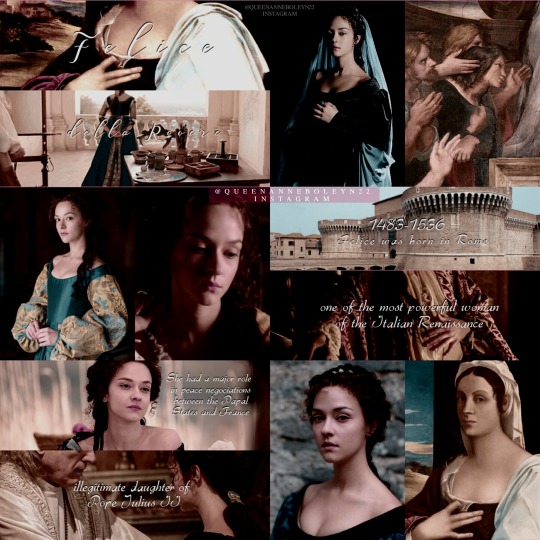
"This lady shares the name of Felice with her grandmother, who was the daughter of Pope Julius II. And she shares not just her name, but also the nobility of her thoughts, the greatness of her soul and the excellence of her regal manner, for which she numbers among the most illustrious personages of the Orsini family."
"Felice has many lessons to impart about self-belief, about standing one’s ground, knowing when and when not to compromise, and about the value of decorum, bella figura, sprezzatura. If she is sometimes intimidating, she is always worthy of admiration and respect. It might have taken almost half a millennium to resurrect her, but Felice is well worth the wait. Her archive of dusty papers is still there in Rome, to be perused by the occasional scholar, and Rome and its environs are replete with memories of her."
Caroline P. Murphy- "The Pope's Daughter: The Extraordinary Life of Felice della Rovere"
#felice della rovere#caroline murphy#italian renaissance fashion#italian renaissance history#italian renaissance#italian history#giuliano della rovere#marta gastini#lucrezia normanni#madonna felice#the mass at bolsena#raphael sanzio#raphael#pope iulius ii#the pope's daughter#gian giordano orsini#16th century#rome
50 notes
·
View notes
Photo

Știri: Vernisajul expoziției „Karol Wojtyła. Geneza” (16 iulie 2020, Râmnicu Vâlcea) Joi, 16 iulie 2020, ora 11.00, pe esplanada din fata Bibliotecii Județene „Antim Ivireanul” Vâlcea va avea loc vernisajul expoziției…
#100 de ani de la nașterea Papei Ioan Paul al II-lea#Adrian Pintea#Ana Ciontea#Biblioteca Județeană ”Antim Ivireanul” Vâlcea#Dan Condurache#Dana Dogaru#Emil Hossu#George Constantin#Karol Wojtyła#Maia Morgenstern#Ovidiu Iuliu Moldovan#papă#Roma#Valeria Seciu#Vasile Mante#Vatican
0 notes
Text
Things nobody is talking about because who cares about Italy (pt. 2 - the sequel)
During the Pride in Rome, a person dressed like Jesus was followed by a sign that said: “to preserve the secular state we need to cancel the treaty with the Vatican” which is something should have be done at least 100 years ago, and was clearly written to wake up all the people who think that the Vatican asking to the State to stop the approval of DDL Zan was a good idea; considering that the closest thing to a Prime Minister we have, Mario Draghi, clearly said he wasn’t going to accept intervention from the Church in something which didn’t concern the Church at all.
Now, Italian politician Mario Adinolfi — who Wikipedia mentions as: “Italian journalist, politician, poker player and blogger. He is famous in Italy for his conservative Catholic beliefs.” - like, I’ve nothing against poker players and bloggers, but MAAAAAAAYBE you should say the fuck away from politics — posted this on his Facebook page - screenshot taken from Commenti Clericabili & Co. -

I’m going to translate this really fast (only highlighted parts cause my stomach couldn’t take more homophobic shit):
“An anti-Vatican sign has been open during the Pride in Rome with a man mocking Jesus Christ. […] I envied the muslins who are able to instill respect of their sacred images, inculcating fear in people like those 4 idiots (he’s speaking about the LGBTQ+ community here). No Gay Pride would have dared to insult Mohammed. […] Our (the Christians’) tolerance it’s what pushed people to do everything they want, including mocking what is most holy to us (I guess with “us” he meant Italy, I don’t know)”
Now, even writing this to let you understand which is the situation the community has to suffer here makes me want to vomit. I want to answer to “dear” Mr Adinolfi, though, and maybe let people understand a little bit what the heck is going on here.
A. I translated the sign, and as you all can see it was nothing anti-Vatican, people are just asking to let a secular state, like Italy is, live without the looming shadow of a foreign monarchy. This rethoric won’t lead at anything.
B. The Pope said he didn’t know about the Vatican request, he wasn’t around, and if he was, he was sleeping. Bullshit, GIANT GINORMOUS BULLSHIT!
C. There’s has been AT LEAST one openly gay Pope in the past (Giuliano della Rovere aka Iulius II, please ask me how I know this! I fucking love Renaissance history) so the entire opposition is just for keeping their fucking Puritan image.
D. Glossing on the poorly hidden racism of his affirmation about Muslins - I don’t want to touch this discourse with a 10mt long pole - he’s basically saying that people should be punished and eventually killed, I guess, for having THEIR OWN OPINIONS and exercising their freedom of thoughts. THE SAME thing Christians asked to be preserved with the non-approbation of DDL Zan. Error 404: coherence not found.
I just… i don’t know how people like him can have an audience and following in this country, which yes, it’s fucked up and I absolutely hate, but it used to be the cultural center of the Western World from the Romans until the end of Renaissance… what the hell went wrong?!
25 notes
·
View notes
Text
Lernante la latinan preter Lingua Latina
Nu, mi pensis ke estus mojose skribi afiŝon pri kion mi lernas preter la libro.
Kiel dirita en la lastaj afiŝoj de Lingua Latina, iujn aferojn mi guglas, ĉar aŭ mi ne komprenas ĝin en la libro, aŭ ĝi ne klarigas (aŭ eĉ ambaŭ). Hieraŭ, mi lernis ion tre interesan.
Quia x Quod
Nu, fakte ĉi-kaze mi ne lernis ion... Ambaŭ estas montritaj kiel "ĉar" en la libro, ambaŭ sinonimaj. Sed, ĉar mi kredas ke ĉiu sinonimo montrita ĝis nun havas siajn etajn diferencojn inter si, mi vere volis scii kiaj estas ili inter "quia" kaj "quod". Rezulto: mi trovis nenion. Simple mi ne trovis retejon kiu klarigas ĝin. Mi nur trovis unu, kie oni diris ke ne vidas diferencon inter ili, kio signifas ke ili estas interŝanĝeblaj. Okej, li studas la latinan ankaŭ, certe scias pli ol mi, sed... Ve, ĝi estas la latina. Ĉu vere ne estas diferenco??
Nu, malfeliĉe mi vere ne havas solvon ĉi tie. Mi elektas uzi "quod", ĉar ĝi estas kion la libro uzas (ĝis nun).
Nam x Enim
Kaj ĉi tie, jes, mi trovis ion.
Rezultas ke ĉiuj ĉi kvar vortoj estas tradukitaj al Esperanto kiel "ĉar", nur unu vorto, same kiel la angla, "because". Ĉi tio faras la kompreno esti konfuza. Mi ne povis kredi ke estus tiom da vortoj kun la sama signifo, sen nenia nuanco inter ili, nenia specifa uzo. Ĝi estus nenecesa, laŭ mi. Feliĉe ĝi ne okazas. Ĉiuj estas tradukitaj kiel "ĉar", sed havas diferencajn signifojn.
Vidu ni ekzemplojn.
Cur avunculus meus in Germania est? Quod milites Germani et milites Romani pugnant, et avunculus teus miles est.
Iulius non solus est, nam quattuor servi apud eum sunt.
Se vi estas pli atentema ol mi estis, vi kaptis ĝin. Mi agnoskas ke mi iomete ĉagrenetis ĉar mi ne sukcesis rimarki ĝin sola... Okej, ni daŭrigu. En la unua frazo, demando estas respondita; en la dua, klarigo estas donita. Kaj jen la diferenco inter ili.
Kaj fakte, en ĉiuj ĝis-nunaj frazoj kiujn la libroj montris, "nam" estas ĉiam uzata kiel klariga konjunkcio, dum "quod", kiel responda konjunkcio. Mi tre ŝatis ĝin. Iel mi ŝatas kiam lingvo havas unu vorton por ĉiu situacio, ĉar ĝi fariĝas pli klara kaj nekonfuzebla, kvankam samtempe ĉi tio malfaciligas ĝin.
Okej, kaj "enim"? "Enim", laŭ la libro mem, estas samsignifa de "nam", tamen estas uzata inverse. Tio estas, anstataŭ "nam quattuor servi...", "quattuor servi enim...". Nun restas la demando: kial? Kaj kiel ĝi povus esti sinonimo? Estas kurioze rimarki ke la libro klarigas ĝin ne uzante "=", sed ":". Mi volas diri, ĉu estus ĉi tiu signo maniero diri ke ili estas similaj, sed ne tute samaj? Vidu la frazon denove sed kun "enim":
Iulius non solus est, quattuor servus enim apud eum sunt.
Ĉu ĝi estas mi, aŭ la senco ŝanĝiĝis ĉi tie?
Oves timent lupos, nam ii eas edunt.
Oves timent lupos, ii enim eas edunt.
Malsamaj, ĉu? Laŭ mi la dua emfazas pli la klarigon ol la unua. Estas kiel uzi "tamen" meze de frazo, anstataŭ "sed" komence. Restas la demando ĉu estas alia traduko krom "ĉar", aŭ ĉu la traduko restas, ŝanĝante nur la sencon inter la vortoj. Laŭ mi, la dua, kun "enim", estas pli emfaza, sed mi bezonas oficialan respondon por esti certa.
Jen kion mi lernis. Ĝi estis pli longa ol mi pensis. Sed mi ŝatis skribi. Ĝis la revido, ĉar ĝi certe ne estos la lasta.
#esperanto#esperanto language#Learning Latin#Latin#Latin language#Linguistics#Grammar#Lingua Latina#lingua latina per se illustrata
2 notes
·
View notes
Text
Protip: Whenever possible, add to the name of a historical person known for something completely different “a published author”. But only if it’s not a lie - like this:
Gaius Iulius Caesar, dictator for life and a published author
or
Catherine II “The Great”, a published author
11 notes
·
View notes
Text
Latin - Alphabet + Pronunciation
Latin 1.1: Vowels, diphthongs, consonants, pronunciation
Long Vowels
a or ā — ah (father)
e or ē — ay (they)
i or ī — ee (seed)
o or ō — oh (note)
u or ū — oo (rude)
y or ȳ — uw (über)
a long vowel in Latin is indicated by a macron (a line over the vowel, ā, ē, ī, ō, ū, ȳ) — but it isn’t typically written out, I’ve just written them to help with pronunciation
Short Vowels
a — a (about)
e — e (bed)
i — ih (pin)
o — (pot)
u — (put)
y — uw (Hütte)
Diphthongs
ae — ai (aisle)
au — ou (about)
ei — ey (hey)
eu — eyoo (feud)
oe — oi (coil)
ui — ooey (gooey)
diphthongs are pronounced as one syllable, and there are only 6 diphthongs in Latin (so if you see “ii” it is not a diphthong — they are separate syllables)
if there are two vowels that would normally be a diphthong, but the second letter has a diaeresis (looks like an umlaut in German), it indicates that the two vowels are separate syllables
Consonants
c — k (can)
g — g (good)
j — y (youth)
r — rr (erre / pronounced as modern day Italians and Spaniards do)
s — s (soft)
v — w (woman)
x — ks (wax)
z — dz (adze)
bs — ps (lapse)
bt — pt (except)
ch — kh (chaos)
gn — ngn (hangnail)
ti — ti (patio)
ph — p-h (top-heavy)
th — t (tourist)
pronounce most consonants as you would in English
i and u can be used as consonants; pronounced as y in yellow (modern Latin texts use j instead of an i when i is used as a consonant, but it retains the y pronunciation
Julius would be Iulius (YOO-lee-oohs)
consonant sounds should be distinct
ch pronounced as k-h in blockhead
ph pronounced as p-h in uphill
*when a consonant is doubled, both consonants are pronounced as separate consonants
tt in admittent pronounced as admit-ten
for pronunciation, it’s a general rule to stress the syllable that is second or third from the last
for 3+ syllables — if next-to-last syllable is heavy, it takes the stress, falls on the syllable before it
a heavy syllable has a
long vowel
dipthong
short vowel followed by two or more consonants (x is considered a double consonant)
Practice (taken from one of the books I’m using)
1: Pāter, cur dignitātem in vīris Romānis non vīdeo
1: Father, why do I not see dignity among the Roman men?
2: Cur me rōgas
2: Why are you asking me?
1: Quod māgna de dignitāte scrībis et dīcis
1: Because you write and speak great things about dignity
2: Fāma in māgnis , dīgnitas autem in humilitāte hābitat
2: Fame live in great things, but dignity lives in humility
If you want to hear how Latin is spoken, I recommend ScorpioMartianus on YouTube. His entire channel is dedicated to the language (like, conversational Latin, songs in Latin and Greek, Latin expressions, and he even does tours in Latin!)
Next post (Latin - 1.2) will cover basic Latin Grammar.
#latin#ecclesiastical latin#latin langblr#latin studyblr#latin alphabet#langblr#studyblr#solis-studies#latin 1.1
13 notes
·
View notes
Photo
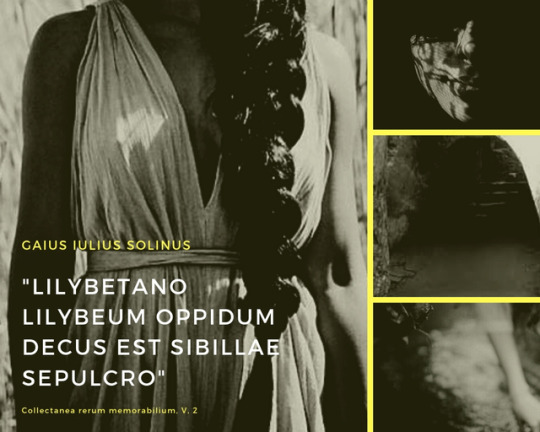
The town of Lilybaeum dignifies the Lilybaean tomb of the Sibyl.
In Ancient Greece, Sibyls were women who prophesied under divine possession (usually Apollo’s) and for this reason they had to remain virgins. Among the various Sibyls, most famous was certainly the one who vaticinated in the Temple of Apollo in Delphi, the Pythia.
Lilibeo Cape (also called Boeo Cape) is the extreme western point of Sicily. In 397 BC, Dionysius I, tyrant of Syracuse, attacked and destroyed the Phoenician colony situated on the isle of Motya. The survivors then founded on the mainland Lilýbaion (lat. Lilybaeum, nowadays Marsala) ”the town that looks on Libya” since from there the Tunisian coast in only 141 km far.
In the outskirt of Marsala, surrounded by the countryside, it can be found the church of San Giovanni al Boeo, built by the Jesuits in XVI century. Previously, the Basilian monastery of Santa Maria della Grotta (lit. St. Mary of the Cave), built in the XI century, once stood in the same area. The small church stands above the so-called Sibyll’s lair. The cave is nowadays around 4,8 meters deep, while in the past it might have been just 1,5 meters deep. It consists of a round principal room, connected to another two, one oriented to the North, while the other one to the West. The main room is partly dug into the rock and covered with a brick dome. A skylight connects it with the Church’s floor. The subterranean room’s floor is decorated with mosaics depicting sealife and most probably realized by African artists between II-III century AD. The fragments of frescoes on the walls (depicting symbolic subjects like a red seashell and at its sides two baskets of fruits, below two doves and bouquets of red roses or leaping fishes and lilies) are contemporary and might have been realized by the nascent Christian community of Lilybaeum. Both in the principal room and the one oriented to the North (equally covered with a dome), two wells pour into two basins. In the Western room, a cavity in the wall gave rise to the legend that it was the Sibyl’s bed.
According to the tradition, in this cave, the Lilybaetan Sibyl lived and did her divinations. The presence of the wells might suggest her predictions involved the use of water (Cryptae illius aqua vaticinandi vim libantibantibus praebere creditur). By drinking the sacred waters, the prophetess was able to divine. The skylight was said to have been used by the worshippers to drop the offerings in the cave to receive in exchange a divine answer to their queries.
This cave was described among many by Diodorus Siculus in Bibliotheca Historica, XIII, 54 (I century BC); Gaius Iulius Solinus in Collectanea Rerum Memorabilium V, 2 (III century AD); Florentine poet Fazio degli Uberti in Dittamondo, III, 14 (1346); Sicilian Dominican friar Tommaso Fazello in De Rebus Siculis Decades Duae (1574 -although he refers to her as the Cuman Sibyl); Dutch philologist and historian Jacques Philippe D’Orville in Sicula, quibus Siciliae veteris rudera, additis antiquitatum tabulis, illustrantur (1764 -he too talks about “Sibyllae Cumanae antrum & sepulcrum”); and French artist Jean-Pierre Houël realized a watercolor of it, which he included in his work Voyage pittoresque des isles de Sicile, de Malta et de Lipari[...] (1782).
Nevertheless, no mention is present in Cicero (who visited Marsala during the investigation against the former governor of Sicily, Gaius Verres) and no archaeological matches attest the concrete existence of this particular cult. It is possible although that the legend might be actually rooted in proto-historic rituals concerning a feminine prophet/healer deity (incidentally in the same area once stood a sanctuary dedicated in II century AD to Egyptian goddess Isis and her temples typically included underground tanks filled with sacred water) that would later merge with the figure of the Greek Sibyl. Indeed, water has always been a crucial point in healing and purification rituals in most religions and cults.
The advent of Christianity caused the disappearance of pagan sacred areas and traditions or their conversion into Christian ones. In this particular case, the water basins of the Sibyl’s lair ended up being used as baptismal fonts, the figure of the pagan prophetess substituted by St. John the Baptist (whose statue was later added in the underground room, placed on a stone altar), who of course has a strong relationship with water. Even the idea that those waters were somehow sacred or at least that they possessed peculiar virtues (specifically, healing ones) was preserved. Famous Sicilian folklorist Giuseppe Pitrè wrote in his book about Sicilian patronal festivals (Feste patronali in Sicilia, 1900) that for many centuries people kept visiting the underground sanctuary to be baptised or drink the holy water hoping to be purified or healed. Especially on St. John’s Eve (the night between 23-24 June), young unmarried women visited the ancient crypt and listened to the water (the so-called ritual of the scutu, listening) to find out if they would get married, while already married women wanted to know whether their husbands had been faithful or not. Also in this occasion, sick people immersed themselves three times (in Name of the Father, the Son and the Holy Ghost) in the water to get better. Giuseppe Pitrè also wrote St. John’s Day was chosen to perform bloodlettings and that during the day they could exceed the number of 400.
#mythology#history of women#archaeology#anthropology#folklore#marsala#roman sicily#greek sicily#myedit#mythologyedit#legends and folklore#culture#province of trapani
23 notes
·
View notes
Audio
13 - Crispia Salvia: la storia di un amore eterno
Nel 1996, nella necropoli di Lilibeo è stato rinvenuto un ipogeo, un monumento sotterraneo unico nel suo genere, perché le pareti della camera funeraria sono interamente dipinte.
Nella tomba, che fu realizzata alla fine del II sec. d.C., è visibile solo una parte dell’epigrafe, l’altra è esposta al Museo.
La lastra di argilla, appesa ad una delle pareti, ci dice che lì era sepolta Crispia Salvia.
Iulius Demetrio racconta il suo amore per la moglie Crispia Salvia, donna “dulcissima” con la quale visse 15 anni “libenti animo” cioè in serenità e armonia.
Scolpito nella pietra un gesto d’amore ha regalato l’eternità a Crispia Salvia.
La voce narrante è di Guarrasi Salvatore
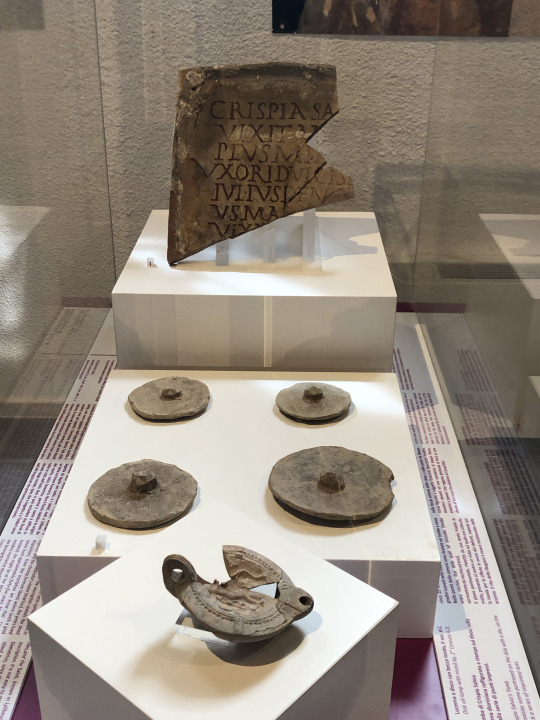

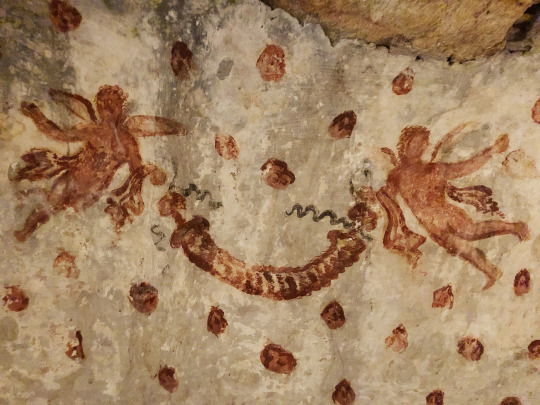
2 notes
·
View notes
Photo

『完美不是一個小細節,然而注重細節卻能造就完美。』 . 3月6日知名壽星:「Il Divino」 米開朗基羅(#Michelangelo,1475 - 1564) . 改變世界文化史,重新定義藝術精髓的雙魚座大師,米開朗基羅,無人不知的盛名,他誕生於昔日佛羅倫斯共和國卡普雷賽(Caprese,今義大利中部Caprese Michelangelo),父親作為地方行政官員,當年似乎也看穿年幼的「小米」似乎不怎麼愛念書,因此在13歲那年,父親讓他從原本教授人文主義的老師門下「畢業」,轉拜師學習繪畫與雕塑,希望孩子能找到自己的夢想跟天空... . 隔年,果不其然,才藝出眾的米開朗基羅從學徒快速晉升至「出師」畫家的行列,開始領取匠人保障薪資。是的,所謂「奇才」者,就是當我們還在國中打滾,音樂課、美術課多半拿來當作英、數平時考的時候,大師本人已經透過專業技法來謀生! . 西元1496年,二十出頭的米開朗基羅隻身來到了羅馬,在法國駐梵蒂岡大使(紅衣主教)的全權委託下,創作了位於聖彼得大教堂(西元1498至1499年間)的「聖母慟子像(聖殤)」(Pietà)...年僅23歲的他,相當滿意自己的手藝,嗯,但是在認為作品可能會被旁人誤認為是大其15歲之藝壇前輩所作之後,連忙將「Michelangelo」的簽名跟著刻上,這個細微的動作,除了以正視聽「米家出品」之外,「聖母慟子像」日後反而成為大師職業生涯唯一一件親自署名的大作。 . 到了西元十六世紀初,隨著佛羅倫斯政經領袖,也就是反對「文藝復興運動」發展的道明會修士遭民眾武力推翻,���至被處以火刑之下,當地的羊毛同業公會決議要將原先被教會擱置的白色大理石雕像建構計畫給繼續完成,以彰顯出佛羅倫斯人不畏強權、崇尚美善的精神,於是聘請米開朗基羅回到故鄉;他用四年的光陰,接續前人的雛型,打造出了高達5米17,重達6噸的…「男性、高清、無碼」藝術雕塑品! . ㄟ,也就是「大衛像」(#David)啦!那讓人歎為觀止的線條布局,超凡的美學觀點,與栩栩如生的工法,全身上下幾乎沒有瑕疵的傑作,讓米開朗基羅聲名遠播,就此奠定了雕刻巨匠的聲望。 . 幾年之後,羅馬天主教教宗儒略二世(Iulius PP. II)向米開朗基羅遞出了新設宗座陵墓的設計案,同時還附加許多大小不一的雕塑品或繪畫零星邀約,其中最著名的案子,乃於西斯廷禮拜堂(The Sistine Chapel )內的天頂壁畫… . 起初教宗是希望米開朗基羅能在天頂星空的背景裡加上十二門徒的畫像,用以崇敬福音使者的腳蹤,但沒想到藝高人膽大的雙魚浪漫,米大師藉由西元1508至1512年間的不斷巧思與細膩工法,竟然以《舊約聖經》的首篇《創世紀》為發想題材,用高達「343」個故事人物來充滿了禮拜堂的天空!而《創造亞當》(The Creation of Adam)裡的「第一類接觸」,智慧生命之火的傳承,今日儼然亦成為文藝復興時期的代表意象,仿作或許不勝枚數,但本尊正是米開朗基羅所繪製的。 . 歷經中年時羅馬和佛羅倫斯兩地的政治動盪,還有教會最高權柄間的角力與更替,同樣在西斯廷禮拜堂,於西元1541年10月停筆,米開朗基羅足以震撼天地的集大成,莫過於祭壇濕壁畫「最後的審判」(Il Giudizio Universale)!他以承先啟後之姿,參考《新約聖經》終篇《啟示錄》裡有關末日審判、基督再來的經文,整整九年的時間,重新定義了文藝復興時期的美學... . 但也因為「羅馬之劫」(Sack of Rome,1527)的破壞,人類自身造成無法挽回的文化浩劫,羅馬城失去歐洲藝文中心的主導地位,教宗也不再有能力和資源成就藝術贊助活動,故「最後的審判」也被視為是文藝復興最後綻放的煙花。 . 高壽88歲,米開朗基羅,留下了實體的經典之作,他的思維與技法更深深影響了數個世紀藝術工作者的風格!而擁有百分百藝術家浪漫個性(他是雙魚座,真的!)的米開朗基羅,十分堅持創作過程與成品輸出的完璧和質感,因此據史實記載,米大師的脾氣相當暴躁,還經常與委託業主們發生激烈的爭執! . 傳說中,他與同時期的另外兩位巨匠,達文西(Leonardo da Vinci,1452-1519)和拉斐爾(Raffaello Sanzio,1483-1520)關係都很緊張…可是有趣的是,人家壞脾氣是壞脾氣,米開朗基羅卻是這文藝復興三大傑當中,享壽最久的呢。 . #義大利 #歷史 #雙魚座 #art #history #birthday https://www.instagram.com/p/CMERgFonNOm/?igshid=15we9skk5duzo
0 notes
Text
Some highlights from a mission...
Or “How I learned to embrace my impending fate and just sigh at my dice”
Which managed to leave Luc with a shoulder wound. Which he doesn’t want the damn healer to treat because he’s already had one bad reaction to aether for the day, that’s his limit...
[3]<Mikhael Lirus> Could we get captured if we wanted? I don't know about you all, but I sure could use a vacation from the snow around the castrum.
[3]<Lucien Korbinius> -looks at Lirus- ....which one of us is the one with questionable allegiances again?
The fact that Lirus and Korbinius have a hate hate relationship has to be no one’s surprise but man, it ratcheted up to a 10 tonight..
Lucien displayed the inability to roll too well unless it was either absolutely needed or somehow against (OOC) someone who shoulda been an ally. (go figure)
[3]<Mikhael Lirus> I may not be able to destory your snowman, Team Ninja, but which of us can climb up onto roofs? >:|
[3]<Scorpius Tacita> ....he has us there.
[3]<Lucien Korbinius> Apparently team 'can't attack the ninjas but watch my grump' Lirus.
^Referencing Winter’s Knell where an engineer out-sabotaged the eir
[3]<Mikhael Lirus> *falls off the roof onto his face*
[3]<Aegir Hlerson> haha
[3]<Mikhael Lirus> My fault for mocking Team Ninja!
[3]<Lucien Korbinius> ....Yes
[3]<Lucien Korbinius> EAT DIRT LIRUS ♥
[3]<Mikhael Lirus> Hush you.
[3]<Lucien Korbinius> No.
[3]<Lucien Korbinius> so my thing holds true! Attacking 'one of us' I can do like.... an 820.
Iota Draconis flops down, not wanting to move any more than she has to.
Mholi'ra Zh'wan was bleeding and wanted just die at the ancient tree of death where his father, fathers father, and his fathers fathers father had died before. BUT NOOOOOOO. Instead he is fucking wreaked by the guy with the shield. He crumbles to the ground in a lump.
Lucien Korbinius | Get rekt.
Iota Draconis gets hit in the shoulder with an arrow. Her head lifts up, she stands and ROARS at the savages shooting at them.
[3]<Aegir Hlerson> SAVAGES♪SAVAGES ♪
Mholi'ra Zh'wan: "...muh honor!" he cries out as he is stripped before passing out again.
[3]<Rafailleur Sangmarche> I needed that aspirin, got a mild headache from all the chaos. Event at late night post-work and such. @.@
[3]<Mikhael Lirus> Sorry!
Lucien Korbinius: "Your honor got lost long ago, twat," he muttered, as he worked on pulling and laying everything out that the ninja had on them.
Zheng Diremite: || Zheng didn't care about other Doman's honor, frankly. "My Shadows are searching for Te Dracu. Centurio, report." He would take Rafailleur's recount first.
[3]<Mikhael Lirus> LUCIEN WOULD KNOW ABOUT THAT
[3]<Lucien Korbinius> the irony of who is saying this to whom... FUCK YOU
Bragi Odinson: "I'm going to fuck Zheng." Bragi murmured.
Rafailleur Sangmarche: "..."
[3]<Shun Ii> please dont fuck zheng
Aedwen Tyrer: "...."
Aegir Hlerson: "Cool."
[3]<Lucien Korbinius> I think you missed a word
Iota Draconis: "........."
[3]<Mikhael Lirus> No sex until the mission is over.
Araceli Caillen: "...I think he is feeling better.."
Albrecht Beringer: "He, ah, must be delirious."
Aegir Hlerson: "I don't think he is...”
Araceli Caillen: "Ah, well, sometimes it goes smoother. Anyway, I am going to check around on people since Lirus is no longer here being-" She looks down as the prisoner sits up. "..!"
Bragi Odinson snorted. "Can't be stronger than Ala Mhigan comraderie."
[3]<Aegir Hlerson> I like that Mholi is naked
Iota Draconis grunts at that particular comment about Mhigans.
Lucien Korbinius: "His shit-arsed sodding fuck-all self," he offered in a pleasant tone.
[3]<Araceli Caillen> ...Wink wink nudge nudge
Mholi'ra Zh'wan hits the floor and squirms under his boot, in that moment he notices Zheng. "Hygh! T-traitor!" he struggles.
Lucien Korbinius shifted his foot quickly, so that the metal of his heel was holding the man by his thraot.
Araceli Caillen: "..Yes, that. Is he your handler than? You got the short straw. Iulius is my handler."
Lucien Korbinius: "Hells the fuck if I know," he muttered, keeping pressure on the man's throat via metal-covered boot.
@aracelicaillen @mikhasunthistle @aegir-ffxiv @braggaman @eldsich ))
14 notes
·
View notes